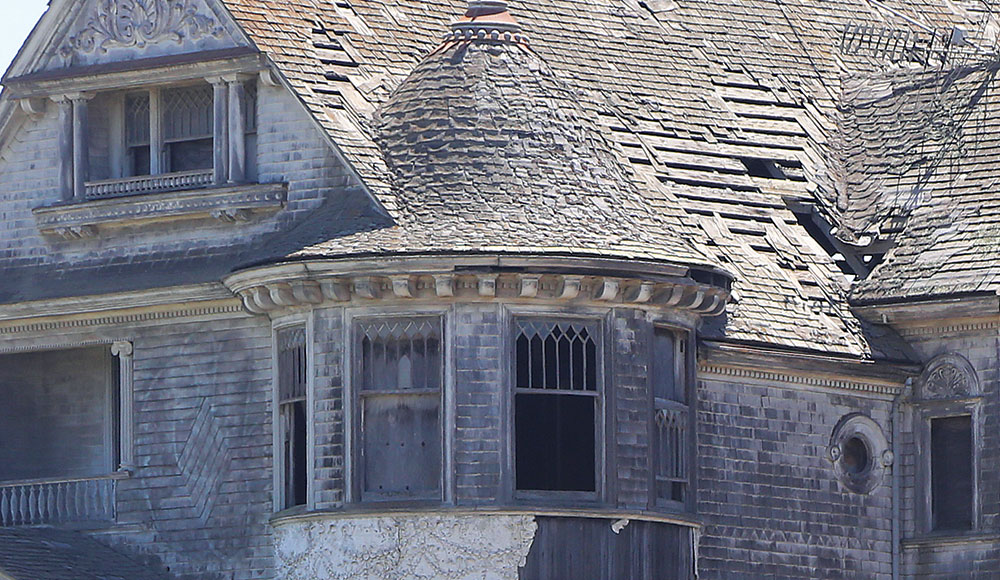The last chapter of the Redman-Hirahara house was written Aug. 5 when the Santa Cruz County Board of Supervisors approved a staff recommendation to delist it as a historic resource.
The decision will allow the property owner to eventually demolish the decrepit 128-year-old building, but not before offering it to the public for salvage.
The resolution will now go to the California Office of Historic Preservation, which will likely remove the house from the National Register of Historic Places.
It is unclear when demolition would happen, but what is certain is that nothing will happen immediately.
Santa Cruz County Mark Connolly said that state and federal entities still have to approve the de-listing.
Connolly added that the current zoning of mixed commercial agriculture will likely be changed to be compatible with the development around it.
That includes a gas station, hotel and coffee shop recently built nearby.
“That would be the eventual goal,” he said. “To foster development that is appropriate for the neighborhood there.”
Juggy Tut, whose company Elite Agriculture owns the property, said he has no immediate plans for either the house or the 14-acre parcel of land on which it sits.
The house’s story began in 1897 when architect William Weeks built a home for sugar beet farmer James Redman.
The Victorian was eventually sold to the Hirahara family, who lived in the house and continued to farm there until World War II, when they were imprisoned in a Japanese internment camp.
Local attorney John McCarthy protected the property so that it stayed with the Hirahara family, who moved back and housed others who had also been sent to the internment camps.
The Hirahara family lived there until the house was red-tagged after the 1989 Loma Prieta Earthquake.
That synopsis, superficial as it is, nevertheless encapsulates the spirit of Pajaro Valley—hard work, friendship and community, with a mix of agriculture and architecture thrown into the mix.
Still, the house’s stateliness notwithstanding, the structure has been deemed uninhabitable, dangerous and unrepairable. Uninhabited and unmaintained for four decades, it has been deemed uninhabitable and, saving for a last-minute donor willing to cough up the millions of dollars it would take to fix up, beyond the reach of restoration.
There were efforts to save the house. The Redman-Hirahara Foundation purchased the property and led efforts to place it on the National Register of Historic Places. That group planned to restore the house and use it as a visitor’s welcome center.
But the economic recession hit and the foundation declared bankruptcy.
The house has now deteriorated to the point where it is considered a safety hazard, said Santa Cruz County Mark Connolly.
The Santa Cruz County Historic Resources Commission agreed, and on Feb. 10 unanimously voted to recommend delisting and rezoning the property.
County Planner Matthew Sundt, who oversees the commission, said that the house would need new plumbing, new electrical, and new redwood lumber sourced from the Santa Cruz Mountains. It would take “millions of dollars” to restore the structure, he said.
“It would be a huge effort,” he said. “Nothing is impossible, but here we are 40 years later. This house—this thing, this grand dame—has been advertised to the world with thousands of people driving by every day. All it takes is one person to say, ‘I’d like to rebuild that.’ And it just never happened, and here we are.”
Becky Steinbrunner, has been at the forefront of recent efforts to keep the house, pointed to Emma Prusch Farm Park in San Jose as an example of a successfully restored historic structure.
She said that the building inspector that deemed the house uninhabitable didn’t bother to go inside.
“This is historic preservation,” she said.
Eloise Shim, who sits on the Historic Resources Board in Salinas, said the house is “the last remnant of a large Victorian estate in a rural setting, which is itself a historic accolade.
“To delist it for the purposes of demolition is a travesty, and should not have been recommended by the historic commission,” Shim said.
Supervisor Justin Cummings, the only dissenting vote, said he has seen examples in the past of historic buildings that were allowed by owners to deteriorate over time, and use that as justification to demolish them.
Supervisor Manu Koenig said that the deterioration is the “inevitable result of years of inaction.”
But the fact that no donor has come forward is evidence it’s time to act, he said.
“If this house was going to be saved—if there was enough community support to save it—then that would have happened by now,” he said.
Supervisor Felipe Hernandez agreed, saying that the house has gone unfunded through times of prosperity and of economic troubles. Anyone who wanted to purchase it, he added, would also have to purchase the property.
“There’s going to be no magic pill, and no one is going to come give us $7 million to fix the house,” he said.
Next, the county will coordinate with a professional historian to document the site for archival preservation funded by the property owner. The supervisors agreed that the property will eventually get a plaque with historic information.













